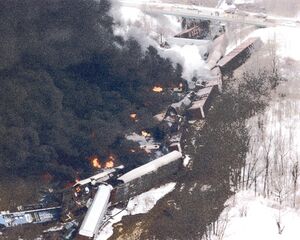Destruction of the AV GV 90-23
AV GV 90-23 was a GV 90 high speed electric tilting train that was destroyed by the Syaran Commonality Air Force on 25 February, 2009. 90-23 had been used by Ruvelka to evacuate civilians from the port city of Aszód due to the risk of encirclement from the Syaran Commonality Armed Forces. During Operation Synaspismos Syaran forces destroyed Ruvelkan rail, road, and telecommunications infrastructure to inhibit the movement of the Imperial Armed Forces of Ruvelka of Army Group South. 90-23 was publicly declared by the Ruvelkan government to only be transporting civilians, however small numbers of Ruvelkan soldiers, predominantly wounded, were also evacuated aboard the train.
Evacuations of Aszód had begun as early as September 2008, but the threat of Syaran offensives following the Ruvelkan Winter Counter-Offensive had led to renewed evacuation efforts. By January nearly half pre-war population of the city, around one million civilians, had evacuated. Although the GV 90 series of trains could carry a smaller capacity than standard rail, its high speed (210 kilometers per hour) allowed it to evacuate people faster; by some accounts nearly 20% of refugees had utilized the GV 90. Debrecen had declared that the GV-90 series would only be used to transport civilians and was therefore protected by international law, but throughout the winter of 2008-2009 Syara accused Ruvelka of using the GV 90 to transport military personnel in violation of its own directives.
On 18 February 2009 Syaran forces launched Operation Synaspismos, which led to unexpectedly rapid Syaran gains and the collapse of the Ruvelkan defensive line in the Aszód District. Faced with the risk of Aszód being encircled, Ruvelkan authorities began a last ditch evacuation effort on the 23rd. 90-23 made dozens of trips between Aszód and Székesfehérvár during this time, evacuating in excess of 12,000 civilians. Included among the civilian populace were small numbers of wounded Ruvelkan soldiers. The final transit of 90-23 began at 10:22 a.m on 25 February; the exact number of passengers was not determined prior to departure, but post event assessment arrived at 492 passengers. At 10:51 a.m the train was intercepted by a Syaran Corvus attack aircraft piloted by Captain Toše Kochevski 10 kilometers outside of Rovirele, who strafed 90-23 with 30mm rockets, two of which damaged the lead and second cars of 90-23, causing immediate derailment. Ruvelkan authorities concluded 90-23 was traveling at approximately 200 kilometers per hour, just under its maximum speed. The high speed, coupled with the sudden destruction of its lead car resulted in the death of the majority of passengers from blunt force trauma. Ruvelkan emergency services responded in under ten minutes and were able to save the lives of 124 passengers. 38 passengers survived the initial crash but died under care. The youngest victim of the crash was 11 months, the oldest was 87.
The Ruvelkan government declared the destruction of 90-23 a war crime shortly after its destruction was confirmed. In subsequent weeks photos of the attack were published in Ruvelkan media and on 6 March the office of Chancellor Edviná Molnár announced that it would seek prosecution of the Syaran pilot responsible for the attack following the conclusion of hostilities, filing charges with the Organization of Tyrannic Nations. Ruvelkan authorities denied that military personnel were aboard 90-23 and photographs of passengers that had been wearing Ruvelkan uniforms (some of which were not actually members of the military) were suppressed. Zovahr insisted that Ruvelka had violated the Sarissita Accords by transporting military personnel, but Ruvelka continued to use the event to attack Syara and accuse Zovahr of perpetuating war crimes. The destruction of 90-23 marked the elimination of the final rail line connecting Aszód with the rest of Ruvelka, and is thus often used to mark the beginning of the Siege of Aszód.
Toše Kochevski, the Syaran pilot who attacked 90-23, was killed during the war and was not identified as the culprit behind the attack until 2013. Syaran government records state that Kochevski was reported missing during the Ruvelkan Autumn Counter-Offensive. An investigation by Ruvelkan authorities cross referenced Syaran records and confirmed that Kochevski had been shot down and killed on 22 September 2009. Ruvelka officially withdrew its court filing with the OTN in 2016. A makeshift memorial was established by the Ruvelkan government in 2011; a permanent memorial was established in 2014 containing the names of the passengers that had been killed.
